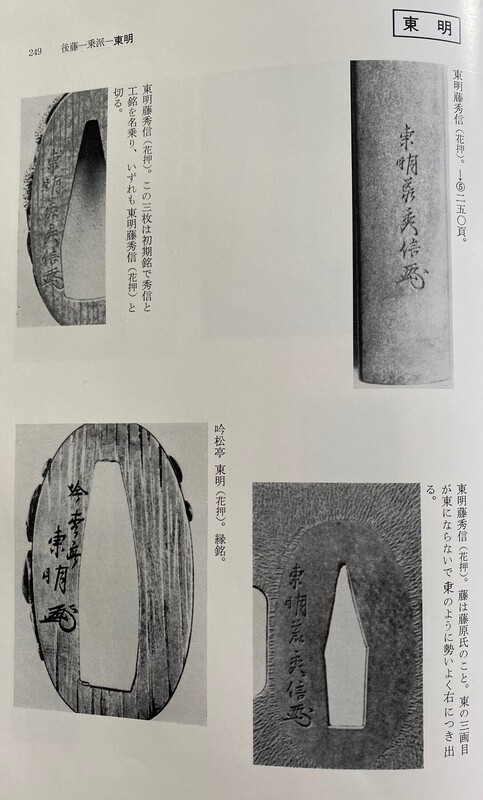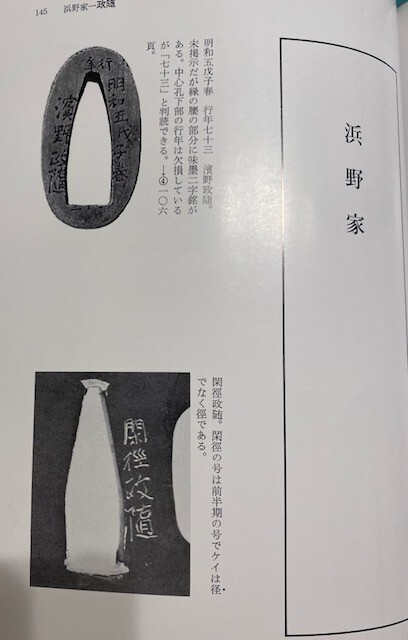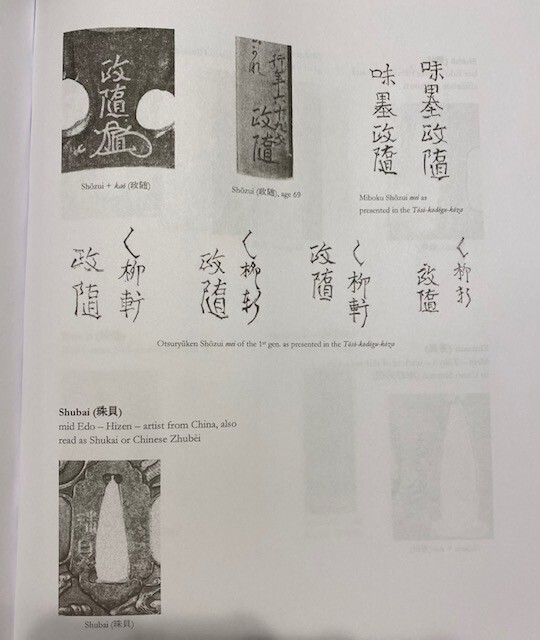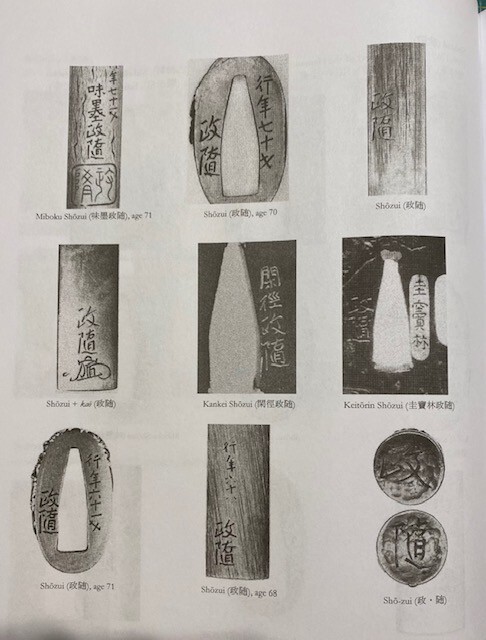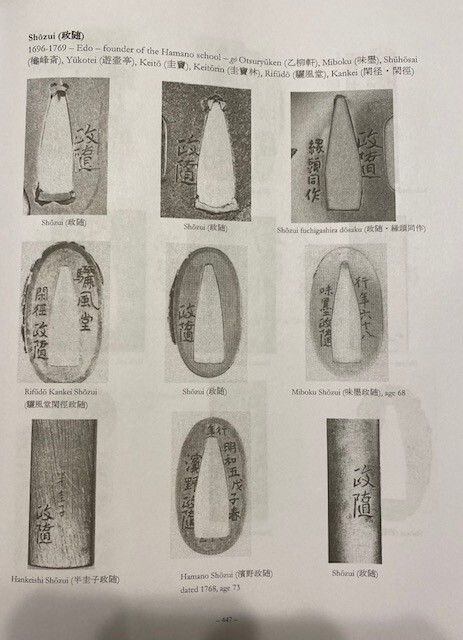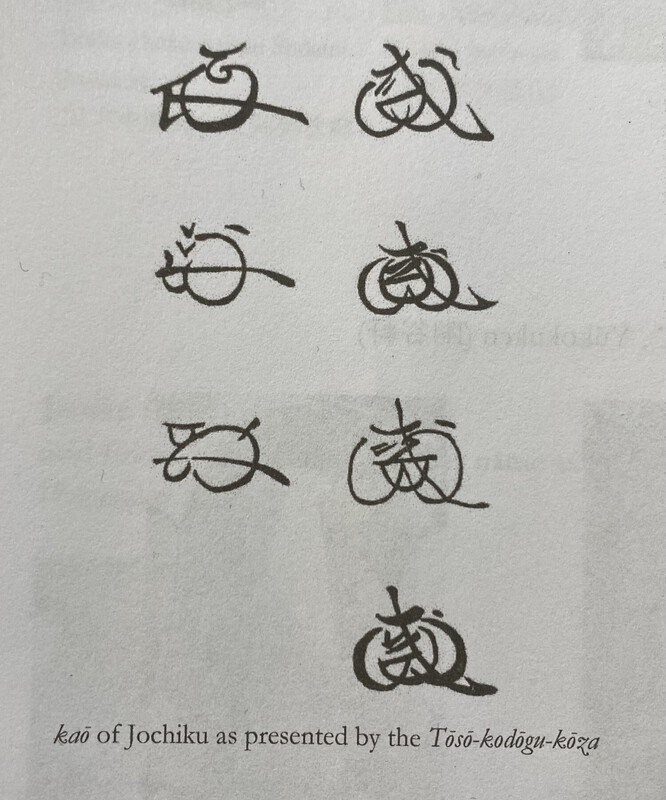-
Posts
858 -
Joined
-
Last visited
-
Days Won
7
Content Type
Profiles
Forums
Events
Store
Downloads
Gallery
Everything posted by Tanto54
-
Exactly - most depictions of Yamabushi just show the "pillbox" type boshi (hat) but some wear the kind of boshi on your tsuba over that pillbox hat. See photo below - notice second Monk from the left is wearing a "pillbox" hat but also has your kind of hat in his hand (the "pillbox" hat alone doesn't provide much protection...) Also, these Monks have 4 "pom poms" on the front and 2 "pom poms" on the back...) P.S. Just guessing here - not very sure....
-
This could be a boshi (hat) and yui gesa that some warrior mountain monks'/ascetics wear around their necks (number 3 in the attached photo - different sects have different configurations and I've seen them with only two "pom poms").
-
Dear Mark, no reason to be disheartened. Everything that you said about your Japanese family friends is generally true of the Japanese and their culture. However, that doesn't necessarily extrapolate to absolutely uniformed tosogu.... From a Japanese perspective, tosogu and koshirae perfectly match your descriptions of your memories (perfection, attention to detail, everything in its place). However some of those attributes may not match your "Western" perspective (e.g., "everything in its place" may be different "places" in different cultures...)
-
Dear Mark, to add to Jean's excellent response, I'd say that in the Japanese aesthetic, a koshirae with the same image on every part in the same color metal would be considered very boring and unartistic. As Jean points out, "matching" in koshirae can often be different but coordinated colors and themes that consist of images that appear completely unrelated to those who do not know or understand the connections. In addition, many koshirae parts were handed down or gifted, so having all the parts be exactly the same was not only undesirable, it was often impossible. For those of us who are a little OCD, many things about the Japanese aesthetic can be disconcerting. For example, the way that Japanese often place the subject far off-center (while most Western Art tends to plop it down in the middle) - see Matt's outstanding kozuka below... However, with study and understanding we can come to appreciate the "flow" and coordination behind the seeming chaos.
-
Dear Bob, sounds like a lucky find while you were on vacation. I like the shape and think the metal will look very good when you finish working on it. Loved your writeup and don't really have anything to add except that I agree with everything you wrote and don't let the knuckleheads tell you that just because it has a mouse/rat it has to be from a merchant's sword (that's a very incorrect myth that just won't die...)
-
Hi Bob, for Item 75, the kashira is signed Miboku which is one of the Go (art names) of Shozui H08803.3 a very famous maker (the "4th" member of the Nara Sansaku). Your fuchi is signed Masatomo H 04573.0 from the Tsuji family. Shozui worked in the early 1700s and Masatomo worked in 1800-50. Therefore, it appears that your kashira (by Shozui) got separated from its original fuchi, so someone commissioned Masatomo to make a matching fuchi. That probably explains the subtle differences in the work, and the famous maker (Shozui) probably explains the impressive provenance.
-
These may be Omori, but they are not Teruhide....
-
Dear Bob, in item No. 74, it does look like the horses are enjoying themselves! I wonder about your mei notes: I see Katsutsugu and Katsuyoshi as different artists. The second kanji in the name is difficult to see and could be several of the variety of kanji that fit these names. Katsutsugu was the 5th master of the Nakai family line and worked in Hagi. I believe that a couple of the Katsuyoshi may have used Hagi in their mei too. Do you know which one it is? Here's a supposed Katsutsugu from Nihonto.us for comparison.
-
Dear Ciro, Your fittings refer to a number of interesting legends. John is correct about the tsuba showing the Dragon King giving the Tide-Controlling Jewels to Hoori (these jewels were supposedly used by Japan in its wars with Korea - see below for more details). Most people will tell you that your fuchigashira is Shoki (The Demon Queller) but it instead it is Watanabe No Tsuna the hero of the Ibaraki-doji legend. There was a demon causing problems at the Rashomon Gate and Watanabe No Tsuna cut off its arm and chased it away (see below for more details). Finally, your menuki (I can only see one) is a Hannya Mask from the Noh Theater representing a female demon. Look up Hannya on the internet and you will find lots of information and several of the stories (the best, in my opinion, is about a woman who becomes very jealous and transforms into a demon incinerating the guy who made her jealous who is hiding under a big metal bell - this is why you often see a serpent with this face coiled around a bell in Japanese sword fittings). Tsuba: There are many variations to the story. Basically, Ryujin is the Dragon King (who is the ruler of the seas) who owns the two Tide Jewels (one can make the tide ebb and the other makes the tide flow). In the story, Ryujin (who is represented wearing a dragon crown or with a dragon on his back) or his messenger Hakuja (who is a white serpent with the face of a man) gives the Tide Jewels to Hoori (his son-in-law). Hoori (also known as Hohodemi or Yama Sachi Hiko) is the mortal Hunter from the Tale of the Happy Hunter (about two brothers - one a fisherman and the other a hunter). The Hunter (Hoori) borrows his brother’s (Umi Sachi Hiko - the fisherman's) magic fish hook and then loses it making his brother very angry. Hoori goes into the sea to find the fish hook and ends up staying for several years and marrying the Dragon King’s daughter. Later, when he decides to return to dry land, the Dragon King gives/sends him the two Tide Jewels, which were later used to defeat the two "Korean Invasions". Some variations of the story includes Hachiman (the God of War) as an infant in the arms of Takenouchi no Sukune (usually represented with a long white beard and royal clothing) who is in a boat being presented the Tide Jewels from the Dragon King (or his messenger) who is in the water. The back of your tsuba may incorporate other elements of this story. Fuchigashira: Here's the story from the Internet - According to legend in the late 10th century of Heian Period Japan, Ibaraki-doji, a notorious Oni, resided at Rashomon Gate in Kyoto. Ibaraki-doji harassed people who tried to pass through the gate until a heroic samurai named Watanabe no Tsuna, a loyal retainer of Minamoto no Raiko, went to subdue the creature. When Tsuna arrived at Rashomon Gate he was carrying a sign that says 'prohibited' (like the one on your kashira - see wood block below), and he was attacked by Ibaraki-doji. However, Tsuna was a strong and valiant swordsman who was able to defend himself against the ferocious attack. The battle raged on until Tsuna drew his katana and severed the arm of the demon. Screaming in pain Ibaraki-doji ran away from Tsuna, leaving the severed arm behind. Tsuna swept up Ibaraki-doji's arm as a trophy. When he arrived home at his mansion he wrapped up the severed arm and locked it away in a chest. A few days later, an elderly woman claiming to be Tsuna's aunt, Mashiba, came to visit him. During the conversation, she aunt asked her nephew to recount how he fought with the demon, and when Tsuna mentioned that he had the severed arm in his possession, his aunt was curious and asked to see it. The unsuspecting Tsuna brought out the chest with Ibaraki-doji's arm inside and when he removed the arm, his aunt revealed herself as being Ibaraki-doji in disguise. She grabbed the arm and escaped from Tsuna's mansion. Tsuna was astonished that Ibaraki-doji had posed as his elderly aunt and did not give chase. However, even after retrieving the arm, Ibaraki-doji never returned to dwell at Rashomon Gate again.
-
Dear Bob, The Buffalo Tsuba (Number 72) is read "Yamashiro ju Nagayoshi saku" (the saku is very faint). He's Haynes 06554.0 and from 1550-1600. Checked the mei in Wakayama and it looks good. The tsuba looks like it was remounted many times in its long life, and the nakagoana looks like it was widened significantly at one time - perhaps for an "armor piercing" blade that was thick but not long in cross-section. The triangular cutouts were probably for sekigane to fit that shorter (cross-sectional) blade. In light of the date of original manufacture (1500's...) and shape/style around the seppadai, I think the filing for the kogatana was added later.
-
Dear Bob, About Item No. 69, after studying the work and mei/kakihan and comparing them to genuine pieces, I believe that it has a high probability of being genuine Tomei. As you pointed out, the bulk of his work is millet, but I've seen a number of his pieces with hirazogan (flat inlay) that match yours very well. While his kakihan looks almost the same throughout his career, there are differences between the one he used when signing Ginshotei and Issai. Often, the copies get that wrong. In your case, the kakihan is correct for his mei of Issai Tomei. Here are some scans from Wakayama for you to compare.
-
Dear Bruno, Nice Tsuba! Haynes has four artists signing with these kanji, but your mei and kakihan only fit two of them: Tanaka Kiyotoshi and his student Bunjiro Kiyotoshi. Haynes says that many of Bunjiro's works are passed for that of his teacher. Looks like the sekegane on yours are a replacement (a little too coarse for this school). Here's a very similar tsuba from Tetsugundo.com for comparison. Really love the moon on yours! BTW - In ancient Japan, Owls were disfavored because the Japanese said that the young often eat the parents making them very disloyal. However, this attitude changed in the last couple of hundred years, so Owls have become more favorable on more recent works of art.
-
To me this "tsuba" has many signs of possible modern casting (perhaps non-Japanese) - looking at the ground, lack of detail, shape of the dragon and tsuba in general. It's not military, of course, but I don't think that it is any older than WWII either (and perhaps much newer).
-
I remember Item #66 from a theme kantei that Ford did here some years ago:
-
The habaki is probably rain and water (instead of cloud) - these swirls are a standard stylization for water (and in light of the proper orientation of a habaki, if it were a cloud, it would be under the rain...)
-
Hi Bob, Nice Fuji-san and boats menuki on item #65! Both Haynes and Sesko say that this artist's name is better read as "Genchin" instead of Mototaka (although both say that some other sources do read it that way or as Motoyoshi). Also, in my Sesko (Toso-Kinko Schools), he doesn't have this artist in Mito or the Oyama/Sekijoken School. Instead he is an Edo artist who studied with Yokoya Somin. Haynes says he lived in the early 1700's, and while he did a lot of Somin-type katakiribori early on, he eventually started his own style and school. Here's a picture.
-
Thanks for doing this for us Paul! I'll study a little and see if I can make a reasonable guess in a bit...
-
Dear Bob, re item no. 53. These two kanji can be read as "Masayuki" or "Shozui". Haynes had dozens of Masayuki but only two signing with these kanji (and he doesn't provide much useful info on them). He also has two Shozui signing with these kanji. One of them is the very famous Hamano Shozui and the other is an Ishiguro artist. Based on the style (and provenance comments), I believe that yours is intended to be Hamano Shozui. He is the founder of the Hamano School and considered as the 4th member of the Nara Sansaku (one of the four greatest artists of that time period). With respect to Shozui, Haynes says: "The majority of the signed examples seen today are forgeries, particularly the tsuba." Here are some mei from Wakayama and Sesko to compare. I hope that @Curran will comment because I believe that he has studied Shozui fairly extensively....
-
Dear Bob, first of all let me say congratulations on the first 50! You have been as regular as clockwork in supplying us with beautiful eye candy every few days for quite a while. I'm sure that all the other NMB members are enjoying seeing your beautiful collection unfold and are looking forward to another 167!!! As for Item 51, it appears that it is a “Tadashige” that Haynes did not have in his original Index, but he added it in his second supplement (Haynes #09149.A). His addition is probably based on your tsuba (see Haynes’ text below where it appears to describe your exact tsuba from a Bonhams Auction). I double checked the dozen or so other Tadashige in his Index and none of the others matched, so I think that Haynes was correct to list this as a “new” Tadashige. In his writeup, Haynes says that [your] tsuba is done with “Murakami Jochiku Haynes #02100.0”, but when I checked that Jochiku, the mei and the kakihan do not match (see the Jochiku mei and kakihan from Wakayama & Sesko below). There is only one other Jochiku in Haynes with your kanji, but his dates don’t match (1865-75). Therefore, it may be a third Jochiku not included in Haynes. In the entry for Jochiku (H#02100.0), Haynes talks about a possible second generation Jochiku (not in Haynes’ Index), but says that there is only very thin evidence for that second generation (perhaps found in the Kokubo, Furukawa, & Mosle references - which could be checked to see if the mei / kakihan match yours).
-
Dear Bob, your Item 50 is a lovely tsuba. I love Dirk's background story on Songoku (the Monkey King). I've attached the signature that you requested from Wakayama (as you may know, Natsuo tinkered with his mei over his life - so lots of different versions). I've also attached a photo of a papered Natsuo fuchi with very similar clouds for you to compare to your tsuba. The writeup of that fuchi on the NMB is very interesting (see the links below). Please remember that Natsuo was copying another artist's work when he made this replacement fuchi, so it may not really reflect his own "original" work style. In addition, I understand that many of his students did a significant amount of work on the pieces that he signed and if their own work met the Master's standards, he or they would sign his mei to those pieces too. Of course, there are many fakes too. Based on a review of Natsuo's records and the nice work on your tsuba, I'd be inclined to agree with your assessment of "studio".
-
@MHC Dear Mark, are you thinking of the "Hoshizukiyo Masamune" that Darcy sold? https://yuhindo.com/hoshizukiyo-kencho/
-
It is a kurikata.
-
Dear Gilles, Sorry, I've been hesitant to comment because I don't have good feelings about this one, but also I don't have any definitive proof of my feelings. I would really need to see it in hand (or have better photos of the inside edges of the ana). Confirming you instincts that this is modern, it appears modern cast/molded to me for the following reasons: As Piers noted, the edges of all the ana are too crisp for any real age. The tagane marks look artificial (not really used to fit to a sword). The bottom of one tagane mark is smooth but the others look cast (see 1st photo - perhaps rust damage instead?). The bonji is fudomyoo, but it looks cast instead of carved (while the rest of the tsuba is very "crisp" there are places where the bonji is not crisp and places where there is metal "above the ground" that would have been chiseled away if the bonji was carved instead of being cast - also can't be rust damage because the metal is "above the ground") - see 2nd photo.
-
Dear Bob, On item 40, there are two modern artists using these kanji for Tadao. One is from Kanagawa (family name Adachibara) and the other is from Tokyo (family name Ito) and both worked in the mid to later 20th Century. One of them is probably your guy. In your post, you mentioned: "I am having some problems with the Tadao (' Tororo Aoi ' ) signature as the plant depicted appears to be Tadao - used in the making of Japanese paper." Just to clarify, the maker's art name is "Tadao" (a common Japanese name) and the plant's name is "Tororo Aoi". The two ("Tadao" and "Tororo-Aoi") are not related. In addition, while I'm no plant expert, I don't think your plant is a Tororo Aoi for several reasons. First, all the photos of Tororo Aoi that I've seen have 5 lobes on the leaves, and some of the leaves on your tsuba have 6 lobes. The berries/flowers on your tsuba do not match the Tororo Aoi plant, and finally, the "yams" or roots/tubors [fruits?] shown at the bottom of your tsuba do not resemble anything from the Tororo Aoi plant either. I did see an old listing from Ginza Choshuya from about a decade ago that listed a Tadao Tsuba with a Tororo Aoi motif, but if that is your tsuba, then I think that Ginza Choshuya got it wrong. You should check to see if you can find a plant that is a better match. Some of the guys on NMB are very good with plants, so let's hope that someone helps us out!













